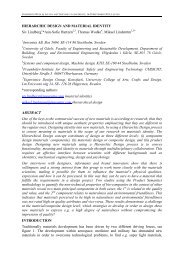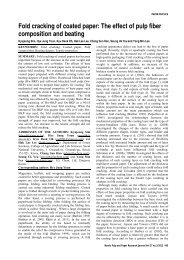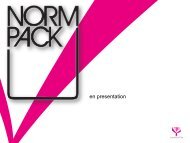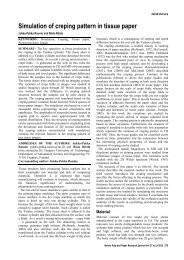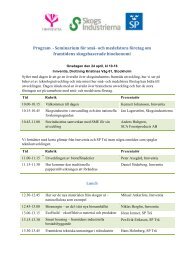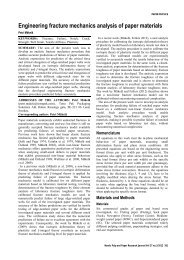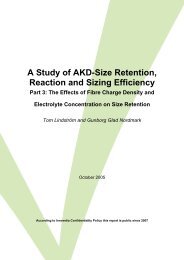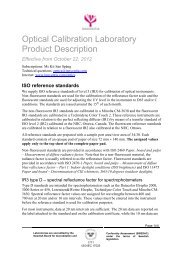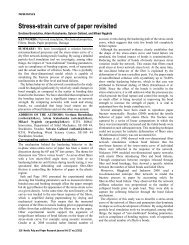3D network simulations of paper structure - Innventia.com
3D network simulations of paper structure - Innventia.com
3D network simulations of paper structure - Innventia.com
Create successful ePaper yourself
Turn your PDF publications into a flip-book with our unique Google optimized e-Paper software.
PAPER PHYSICS<br />
Table 1. Properties <strong>of</strong> fibers and simulated 60 gsm sheets, 1x2 mm sample (20F represents fines, fiber objects consisting <strong>of</strong> single<br />
elements).<br />
Parameter<br />
S<strong>of</strong>twood pulp Mix 1<br />
Mix 2<br />
Mix 3 Hardwood pulp<br />
0HW+100SW 50HW+50SW 64HW+16SW+20F 80HW+20SW 100HW+0SW<br />
Fiber Length (Avg.), mm 3.0 2.0 1.2 1.4 1.0<br />
Fiber Width (Avg.), μm 24 24 24 24 24<br />
Elastic Modulus Fiber, GPa 10 10 10 10 10<br />
Caliper, μm 100 100 100 100 100<br />
Number <strong>of</strong> fibers 612 783 1162 952 1111<br />
Elastic Modulus <strong>of</strong> sheet, GPa 6.433 5.920 4.309 4.278 2.959<br />
Stiffness (mN·m), simulated 0.536 0.493 0.359 0.356 0.246<br />
Stiffness (mN·m), experiment<br />
(Lavrykov et al., 2010)<br />
0.763 0.703 0.693<br />
Wet Pressing Pressure, MPa<br />
60,0<br />
50,0<br />
40,0<br />
30,0<br />
20,0<br />
10,0<br />
S<strong>of</strong>twood<br />
Hardwood<br />
0,0<br />
0,4 0,5 0,6 0,7 0,8<br />
Density, g/cm 3<br />
Fig 17. Pressure as a function <strong>of</strong> mat density<br />
Table 1 below shows the results <strong>of</strong> <strong>simulations</strong> <strong>of</strong> 60<br />
gsm sheets <strong>com</strong>posed <strong>of</strong> a mix <strong>of</strong> hardwood and<br />
s<strong>of</strong>twood pulps in different ratios along with a portion <strong>of</strong><br />
the fines. Note that the mixes are shown in number<br />
fractions (not mass) as is usual for experimental data. The<br />
simulation results show that the sheet modulus is a strong<br />
function <strong>of</strong> the s<strong>of</strong>twood content, increasing in magnitude<br />
as this increases. An important parameter, the sheet<br />
stiffness was also evaluated and shown to be a strong<br />
function <strong>of</strong> the s<strong>of</strong>twood content in the pulp. The final<br />
rows in this table present stiffness estimates using the<br />
<strong>simulations</strong> as <strong>com</strong>pared to data obtained from<br />
experiments. It appears that when the elastic modulus <strong>of</strong><br />
the fibers is assumed to be the same, the longer fibers<br />
yield a higher stiffness value, a trend that corresponded to<br />
the experimental results. The magnitudes <strong>of</strong> the<br />
stiffnesses observed experimentally are much higher than<br />
the simulation predictions though. The modulus <strong>of</strong> the<br />
fibers and other parameters were obtained from published<br />
values in the literature rather than measurements or<br />
estimates on the furnish itself. This would account for the<br />
difference in magnitude <strong>of</strong> the estimates.<br />
Simulation <strong>of</strong> Wet Pressing <strong>of</strong> Sheets<br />
The most significant use <strong>of</strong> simulation is to predict the<br />
<strong>structure</strong> <strong>of</strong> the <strong>paper</strong> sheets with particular reference to<br />
their z-dimensions i.e. the caliper or analogously, their<br />
density. This is not possible with 2D <strong>simulations</strong> and also<br />
simplistic constructions allowing the fibers to bend<br />
according to external rules. The best method <strong>of</strong><br />
simulation is to determine the fiber reaction force during<br />
<strong>com</strong>pression, the so-called <strong>com</strong>pressive stress and also<br />
simultaneously track the drag force exerted by the<br />
moving fluid. This is possible with a particle level<br />
simulation such as the present one. The fiber<br />
displacements were simulated using LS-DYNA. At each<br />
step <strong>of</strong> pressing, the fiber reaction force was summed and<br />
used as the total <strong>com</strong>pressive stress borne by the fibrous<br />
<strong>structure</strong>. The <strong>com</strong>bination <strong>of</strong> the drag, translated into<br />
permeability and the <strong>com</strong>pressive stress was applied to a<br />
homogenized wet pressing model (Lavrykov et al., 2009)<br />
to determine the sheet caliper at different values <strong>of</strong><br />
applied pressure. The hydraulic stress was estimated<br />
using an effective medium type approximation with<br />
periodic cells, adjusted for local change in porosity.<br />
These were <strong>com</strong>bined to generate the <strong>structure</strong> in a timeexplicit<br />
method. Fillers (or equivalent fines) were<br />
considered as single discrete elements <strong>of</strong> approximately 2<br />
to 4µm in size. This allowed the calculation <strong>of</strong> the sheet<br />
caliper and density at given levels <strong>of</strong> applied pressure and<br />
the as a result, the sheet <strong>structure</strong>.<br />
Discussion<br />
As was mentioned before, the main objective <strong>of</strong> this work<br />
was to provide a new method for the generation <strong>of</strong> fiber<br />
<strong>network</strong>s which can be applicable to numerical solution<br />
<strong>of</strong> mechanical problems. This means fibers in an artificial<br />
mat should consist <strong>of</strong> set <strong>of</strong> finite elements connected in<br />
nodes. During mat formation fibers should not be bent<br />
only but <strong>com</strong>pressed too taking into account possible<br />
fiber collapsing. In this situation all previously reported<br />
methods (Nilsen et al., 1998; Provatas et al., 2000;<br />
Heyden 2000; Heyden, Gustafsson 2002; Vincent et al.,<br />
2009; Vincent et al., 2010) were found not correspondent<br />
to our goals.<br />
To provide a simulation <strong>of</strong> fibers settling and<br />
<strong>com</strong>pression the explicit analysis s<strong>of</strong>tware was used.<br />
There are several important reasons for using explicit<br />
analysis instead <strong>of</strong> the implicit one for solution <strong>of</strong> this<br />
type <strong>of</strong> problems. First, the explicit methods perform this<br />
analysis much faster. For example, for the sample in Fig<br />
7, which contains about 2000 fibers with 120,000<br />
elements and 500,000 nodes, the solution <strong>of</strong> the static<br />
elastic problem using the implicit method on a PC<br />
<strong>com</strong>puter with two Xeon Quad Core 3 GHz processors<br />
and 24 GB RAM under 64-bit Windows 7 operational<br />
system requires 4 Hrs. During solution <strong>of</strong> nonlinear<br />
elastic-plastic contact problem with large strains and<br />
Nordic Pulp and Paper Research Journal Vol 27 no.2/2012 261



